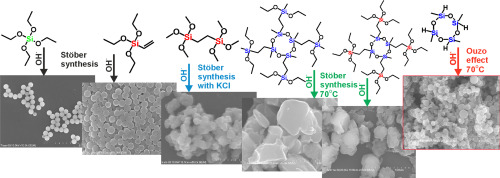当前位置:
X-MOL 学术
›
Mater. Des.
›
论文详情
Our official English website, www.x-mol.net, welcomes your feedback! (Note: you will need to create a separate account there.)
Design and characterization of silicone micromaterials: A systematic study
Materials & Design ( IF 8.4 ) Pub Date : 2018-05-01 , DOI: 10.1016/j.matdes.2018.03.010 Joanna Lewandowska-Łańcucka , Magdalena Staszewska , Michał Szuwarzyński , Szczepan Zapotoczny , Mariusz Kepczynski , Zbigniew Olejniczak , Bogdan Sulikowski , Maria Nowakowska
Materials & Design ( IF 8.4 ) Pub Date : 2018-05-01 , DOI: 10.1016/j.matdes.2018.03.010 Joanna Lewandowska-Łańcucka , Magdalena Staszewska , Michał Szuwarzyński , Szczepan Zapotoczny , Mariusz Kepczynski , Zbigniew Olejniczak , Bogdan Sulikowski , Maria Nowakowska

|
Abstract Silicone micromaterials were synthesized using two surfactant-free methods: the Stober synthesis or solidification in spontaneously formed emulsions (the Ouzo effect) and their physicochemical properties were evaluated. The effect of the chemical structure of a silicone precursor on the morphology of formed microstructures was considered. For that purpose, various organosilicon compounds containing in their structure T-units and D-units, methyl groups, ethylene linkages, and cyclotetrasiloxane rings were used as silicone precursors. All materials existed as sub-micron sized particles, although they differed considerably in morphology and dispersity (spherical particles with a diameter of about 490 and 740 nm, cauliflower-like structures, large rough-surfaced aggregates). The chemical composition of the microstructure surface was examined using XPS. The porosity of silicone materials was assessed on the basis of nitrogen adsorption isotherms. The specific surface area (SBET) varied substantially and ranged from 5 to 379 m2/g. For the first time the microelastic modulus of the silicone materials was determined using AFM measurements. We found that the structure of the organic part had a large impact on the microelasticity of the material. The microelastic modulus of the silicone materials (11–33 GPa) was significantly lower compared to silica (59 GPa).
中文翻译:

有机硅微材料的设计和表征:系统研究
摘要 使用两种无表面活性剂的方法合成有机硅微材料:Stober 合成或在自发形成的乳液中固化(Ouzo 效应),并对它们的理化性质进行了评估。考虑了有机硅前体的化学结构对形成的微结构形态的影响。为此,使用在其结构中包含 T 单元和 D 单元、甲基、乙烯键和环四硅氧烷环的各种有机硅化合物作为有机硅前体。所有材料都以亚微米尺寸的颗粒存在,尽管它们在形态和分散性上有很大差异(直径约为 490 和 740 nm 的球形颗粒、菜花状结构、大的粗糙表面聚集体)。微结构表面的化学成分使用 XPS 检查。基于氮吸附等温线评估有机硅材料的孔隙率。比表面积 (SBET) 变化很大,范围从 5 到 379 m2/g。有机硅材料的微弹性模量首次通过 AFM 测量确定。我们发现有机部分的结构对材料的微弹性有很大影响。与二氧化硅 (59 GPa) 相比,有机硅材料的微弹性模量 (11-33 GPa) 显着较低。有机硅材料的微弹性模量首次通过 AFM 测量确定。我们发现有机部分的结构对材料的微弹性有很大影响。与二氧化硅 (59 GPa) 相比,有机硅材料的微弹性模量 (11-33 GPa) 显着较低。有机硅材料的微弹性模量首次通过 AFM 测量确定。我们发现有机部分的结构对材料的微弹性有很大影响。与二氧化硅 (59 GPa) 相比,有机硅材料的微弹性模量 (11-33 GPa) 显着较低。
更新日期:2018-05-01
中文翻译:

有机硅微材料的设计和表征:系统研究
摘要 使用两种无表面活性剂的方法合成有机硅微材料:Stober 合成或在自发形成的乳液中固化(Ouzo 效应),并对它们的理化性质进行了评估。考虑了有机硅前体的化学结构对形成的微结构形态的影响。为此,使用在其结构中包含 T 单元和 D 单元、甲基、乙烯键和环四硅氧烷环的各种有机硅化合物作为有机硅前体。所有材料都以亚微米尺寸的颗粒存在,尽管它们在形态和分散性上有很大差异(直径约为 490 和 740 nm 的球形颗粒、菜花状结构、大的粗糙表面聚集体)。微结构表面的化学成分使用 XPS 检查。基于氮吸附等温线评估有机硅材料的孔隙率。比表面积 (SBET) 变化很大,范围从 5 到 379 m2/g。有机硅材料的微弹性模量首次通过 AFM 测量确定。我们发现有机部分的结构对材料的微弹性有很大影响。与二氧化硅 (59 GPa) 相比,有机硅材料的微弹性模量 (11-33 GPa) 显着较低。有机硅材料的微弹性模量首次通过 AFM 测量确定。我们发现有机部分的结构对材料的微弹性有很大影响。与二氧化硅 (59 GPa) 相比,有机硅材料的微弹性模量 (11-33 GPa) 显着较低。有机硅材料的微弹性模量首次通过 AFM 测量确定。我们发现有机部分的结构对材料的微弹性有很大影响。与二氧化硅 (59 GPa) 相比,有机硅材料的微弹性模量 (11-33 GPa) 显着较低。



























 京公网安备 11010802027423号
京公网安备 11010802027423号